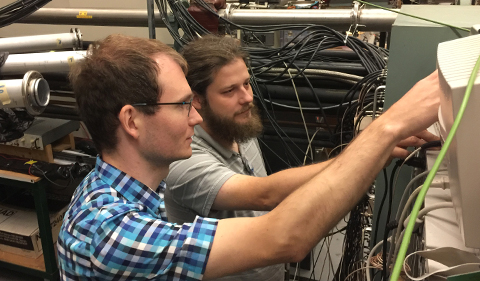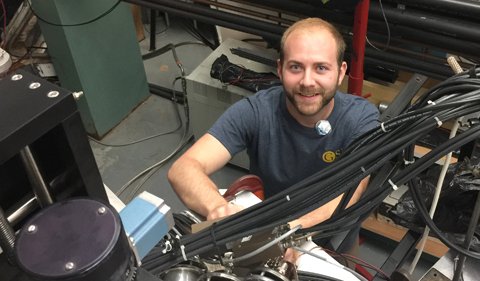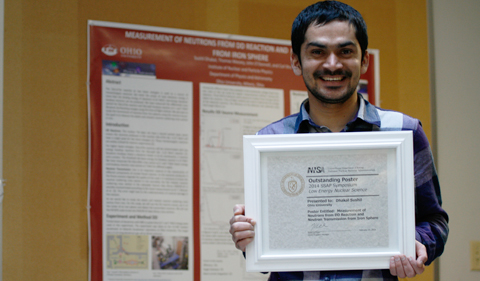
University of Notre Dame Postdoctoral Researchers Patrick O’Malley and Axel Boeltzig use ROOT, a C++ software developed for plotting and analyzing data, to inspect a 2D spectrum of time-of-flight vs. energy of the charged particles seen by their detectors.
Ohio University Physics & Astronomy professors Drs. Carl Brune, Alexander Voinov, and Thomas Massey of the Institute of Nuclear and Particle Physics recently hosted a group of nuclear physicists from the University of Notre Dame for a week at the John C. Edwards Accelerator Laboratory.
Notre Dame doctoral candidate Bryant Vande Kolk headed the experimental setup and measurement with support from members of his research group at Notre Dame and collaborators at OHIO.
They wanted to learn how nuclear reactions performed in a laboratory such as OHIO’s Edwards Accelerator differ from those that occur in stars. While the laboratory often has targets of neutral charge, the stellar environment is made up of dense plasma and consequently contains a great number of electrons. This is an important distinction because what the electrons are doing (bound in atoms versus being free in plasma) may affect the rates of nuclear reactions.
The Notre Dame researchers wanted to determine the cross section of a boron fusion event, known as the 10B(p,α)7Be reaction, over energy ranges not previously studied. The team accelerated protons to collide with a solid boron-10 target, and studied how often beryllium-7 and alpha particles, or helium-4, were produced.
“These electrons can reduce the repulsive effects that positively charged particles have with each other, meaning we notice higher rates of reactions among these particles,” Vande Kolk explains. To study this effect, known as plasma screening, the researchers compare laboratory results of a reaction with results from a stellar plasma reaction.
Next steps include using a facility like the National Ignition Facility at the Lawrence Livermore National Laboratory in California to study the stellar side of the reaction. The group wants to collect the 7Be created and compare it to what was created in the lab. They will collect the 7Be from reactions at NIF (which is a plasma, like a star) and compare it to measurements at an accelerator lab (like at Notre Dame or Edwards).
“7Be has a convenient half-life of about 50 days, long enough to collect and count, but short enough not to be a problem for those trying to monitor/store radioactive by-products at the NIF,” Vande Kolk says.

ND Postdoctoral Researchers Axel Boeltzig and Kevin Macon use an oscilloscope to visually inspect the signal coming from the detector.
The team hopes that by characterizing the cross section for this reaction over the energies they study will better constrain their simulations to lower energies that are accessible to NIF. Measurements at accelerators, using a wide range of energies, can determine what is termed the “bare nuclear cross section” which is what would happen if there were no electrons. From that one could try to predict what would happen at NIF.
Before traveling to OHIO’s Edwards Accelerator Lab, the Notre Dame team performed this experiment with its 5 MV machine at Notre Dame with success. However, at certain energies, the data showed that they could not distinguish the signals of an alpha particle and a proton. Using a method at Edwards Accelerator Lab called “time of flight,” they were successful in being able to identify the protons from alpha particles.
Time of flight measures the time that it takes for an object or particle such as a proton to travel a distance through a medium, in this case boron. The procedure worked because lighter particles travel faster than heavier particles with the same energy. The Edwards Accelerator Lab is one of very few places in the world that can study these energies using the time of flight method.

ND Doctoral Student Bryant Vande Kolk adds a pulser cable to a detector to test its time of flight signal.
“By performing over 85 runs at 23 different energies in a week’s time, we were able to make the more selective measurements,” Vande Kolk says. “The Edwards Accelerator staff members have been helpful, knowledgeable, and welcoming, and the techniques used in this experiment are extremely useful. We hope to return to Edwards Lab to perform even more of these kinds of experiments in the near future.”



















Comments